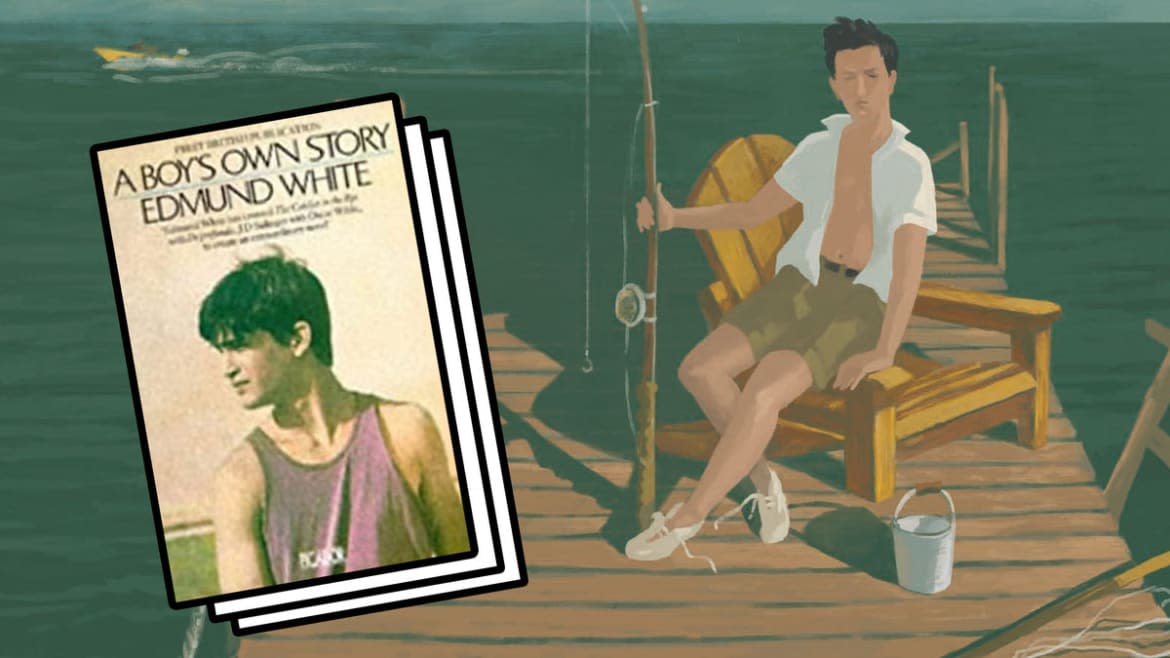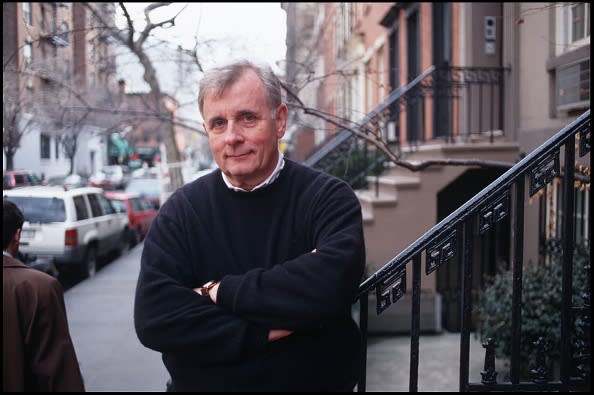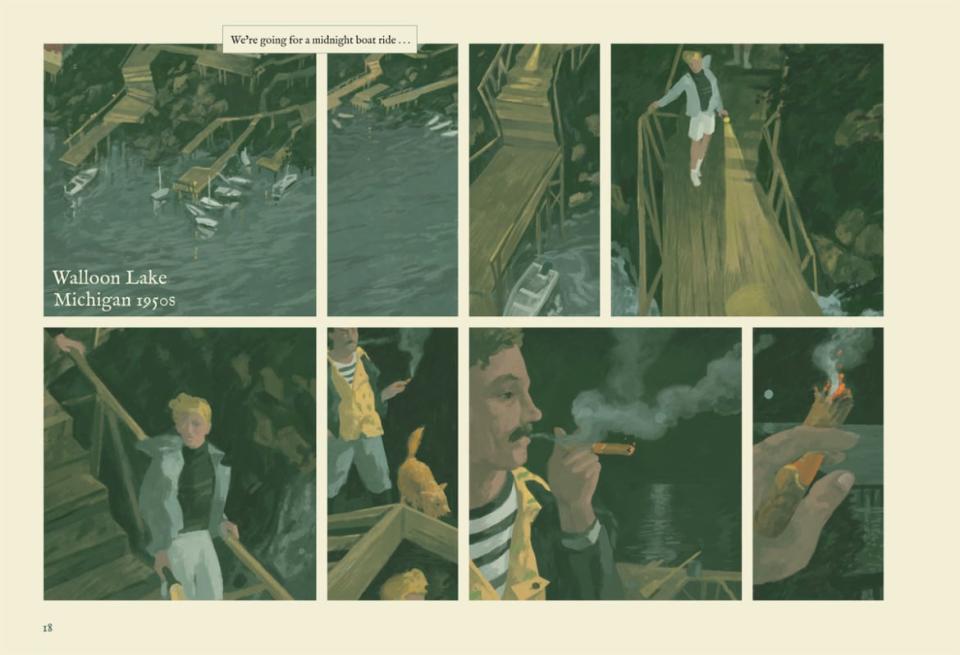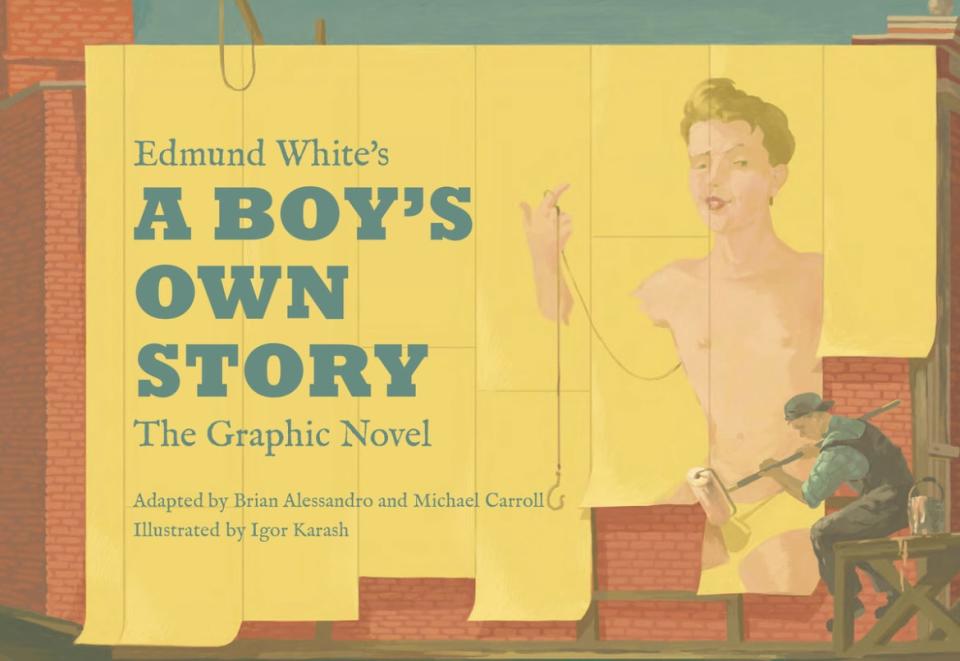‘A Boy’s Own Story’ Is a Gay Classic. Now It’s a Graphic Novel

- Oops!Something went wrong.Please try again later.
- Oops!Something went wrong.Please try again later.
Of course, Edmund White was writing when The Daily Beast arrived at his Manhattan apartment. The novel-in-progress is called Losing It: A Ghost Story, inspired by a nephew whom White had once cared for, and who, at 50, committed suicide. White had been writing poems too, he said, while proffering the bound proof of another novel, The Humble Lover, due to be published in May, about a beguiling male ballet dancer caught up in a multitude of rich-person intrigues.
“I don’t have anything else to do,” White said, smiling, of his relentless production of words.
Edmund White: Sex, Success, and Survival
White, the much-laureled monarch of modern queer literature, is a writing engine of fiction, non-fiction, biographies (including of Jean Genet), and memoirs (including of his time living in France in Our Paris: Sketches From Memory and Inside a Pearl: My Years in Paris). Unsurprisingly, in his and husband Michael Carroll’s Chelsea apartment, books are piled high. With mottled daylight struggling to assert itself through the windows, lamps illuminate their spines. The books—old, new, hardback, paperback—are the cushion and covering of every surface. White says he doesn’t suffer from writer’s block or fret over narrative structures, but rather aims for what “Forster called the horizon—the point you want to get to in a book, even if you’re not sure how you’ll get there.”
Now the couple have a new addition to their bustling library: the graphic novel version of A Boy’s Own Story, White’s 1982 autobiographical coming-out novel long considered a classic by generations of readers, LGBTQ and otherwise. Now, it has become an illustrated book (Top Shelf Productions, $29.99), written by Carroll and writer, artist, and filmmaker Brian Alessandro, with dreamy, Edward Hopper-ish illustrations by Igor Karash. The book has been in gestation for around five years, said Alessandro, and the group worked on it concertedly during the pandemic.
That period of time meant he and White had kept “weird hours and weird behaviors,” said Carroll. “Oh, you should hear about some of our weird behaviors,” deadpanned White. Soon to turn 83, he said he had been “totally hands-off” when it came to the graphic novel. “I trust Michael 100 percent.”
For Carroll, 58, the biggest challenge was imagining dialogue in a novel that had originally been full of indirect speech, and hope that the new format could allow an already iconic book to “echo beyond its original dimension,” and reach a new, younger audience with striking drawings and pacy plotting. “We didn’t want to lose the reader for one minute. The original novel is already very ambitious, I don’t think it’s going to be bested in terms of its daring. But it has to be said, there’s a lot of coming-out novels in the world now.”
The panels of the graphic novel evoke the young narrator Eddie’s first sexual experiences with a fellow teen, and his troubled and complex relationship with his parents, with the narrative spinning forward and back in time from the 1950s to 1990, which the original novel didn’t do.
As White told this reporter in 2014, he grew up in Cincinnati, Ohio. His father—presented in the graphic novel with a luxuriant pornstache he never actually had—was an entrepreneur of varied fortunes. His parents divorced when he was 7; White lived with his mother and sister Margaret (to whom he remains very close) in Chicago, and returned to Cincinnati and his father for the summers.
“I never liked my father,” White said. “He really was a dullard and misanthrope. My mother and he were married for 22 years and it was an ill match. She encouraged me to be a writer… She didn’t care later when I wrote about her. ‘Well, I came off better than you did,’ she’d say to my sister.”

Edmund White poses for a portrait on W22nd Street on February 28, 2000 in New York City, New York.
White majored in Chinese at the University of Michigan and moved to New York in the early 1960s, working for Time-Life Books. In the 1970s, he and a collection of gay writers, including Andrew Holleran and Felice Picano, formed a club called The Violet Quill. In the graphic novel we see the flaxen-haired Eddie at the Stonewall Riots (yes, White was there), and his sex and desire-permeated lives in Paris and New York.
Many years ago White co-wrote The Joy of Gay Sex, which he was, and remains, eminently well-qualified to write about—and has done, including his time as an S&M slave to a much-younger master. AIDS and its devastation marks where the graphic novel ends in 1990. White was 50 at the time; a “slow progressor,” he has lived with HIV himself for almost 40 years, and has written about its impact, both personally and culturally, in many books.
White once told me he had been criticized by the author and activist Larry Kramer for not writing about AIDS in the 1980s. “Larry attacked me as viciously as anyone has. When The Farewell Symphony came out, he wrote that my asshole was as busy as a toilet. I was very angry, but I’m a nice forgiving guy, so I forgave him. I was nice to him at parties.”

Alessandro, a friend of White’s, told The Daily Beast of writing the graphic novel, “It was a very tall order. The original book is 40 years old. I know it's Ed’s most famous book. He has a legion of fans who really appreciate it, and look to it as a kind of inspiration and model. It was a little bit intimidating at first but also an exciting opportunity. I do my best when challenged, and working with Michael Carroll on it made it a lot easier.”
“One of White’s innumerable gifts is that he can write frankly and graphically about sex and still find nuance, sanctity, and elevation,” Alessandro wrote in his review of White’s last novel, A Previous Life, in January 2022—and this combination of qualities is also woven into A Boy’s Own Story in graphic novel form. What we can learn most from the French, White once told this reporter, is about experiencing something simply for pleasure, taking pleasure from life, “enjoying pleasure for pleasure’s sake, including in sex.”
The idea of the time switches, showing the trajectory of Stonewall, LGBTQ liberation, and the AIDS pandemic, was to give readers “something additional and unexpected to chew on,” said Alessandro. “It’s to show a panoply of gay men’s experiences through that time period—oppression, liberation, and devastation. Ed wrote a biography of Proust, and we wanted this to have a Proustian quality too, of Ed walking through his past and interacting with his boyhood self and memories in the same space.”
Alessandro, a former teacher, hopes the graphic novel brings a younger generation to the landmark novel. “I was really shocked how little history many of my students knew—not ancient history, but the last 50 years of it. So few people in their teens and early 20s have a grasp of what went down a few decades ago. Also, it may be a little too idealistic, but I hope the novel inspires people who are closeted to come out, and maybe educate some bigots. That might be lofty, but it’s something to aspire to.”
“A book ban would certainly get us noticed,” Carroll said of one prevailing symptom of the rising tide of anti-LGBTQ bigotry in America.
“Those on the right wander around needing objects for their fury. Gays are always good for that, I guess,” said White.
Karash is straight, and Russian by birth. When the book’s editor Ryan Runstadler told him of the book’s more sexually charged moments. Karash said, “I was worried how I would project that specific gay desire, but I tried to dive deep in the reading. I like to work on anything which accomplishes a greater goal. From the first few pages of the book, I was totally engaged. For me, there are a lot of universal things in the book. Yes, it’s controversial in places, but we are in a different time and place now. Growing up in the Soviet Union, sexuality in general was a taboo. It wasn’t in literature, film, anywhere. If you asked questions, no one answered.”
“There are a lot of Easter eggs in it”
Carroll had first read the original Boy’s Own Story in his early twenties, after reading White’s survey of late 1970s queer America, States of Desire.
The graphic novel team wrote by committee: “I felt like I was the guardian of the original book, of getting too far away from it. It was an interesting process. Everyone had to agree on everything as a group,” Carroll said.
“Just like Kevin McCarthy,” White said drily—at the time, so, so long ago, when McCarthy had just lost the second of what would take 15 rounds of votes to become speaker of the U.S. House of Representatives.
White thought the completed graphic novel was “very beautiful. I was momentarily taken aback by the jumping around in time, because as a coming-out novel, I felt it was something the character was doing in a linear way, very slowly. But then I realized the time jumps were a good thing because one of the problems I had with the original novel was how to indicate to the reader that everything turned out all right, which the graphic novel conveys in a very direct way.”
Alessandro said three LGBTQ artists were too nervous to take the project on, because of its depictions of teen sexuality.
“The most challenging thing was the sexual nature of the book and the sexually explicit situations it describes,” Karash said. “The language of the book is extraordinary and elegant, and I wanted the illustrations to be elegant and not too anatomical and porn-like.” (Karash has also created the cover of Alessandro’s new novel, Performer Non Grata, which will be released by Rebel Satori Press in April.)

Alessandro has a background in clinical psychology, and said that Runstadler thought the project had a Freudian quality to it, mapping the journey of a 13-year-old closeted gay teenager to becoming a 50-year-old out gay man. There’s a quietly epic intent to the book, reaching “across decades, places and countries,” Alessandro said. “Forty years on from when the book was first published, we have the luxury of applying an analysis to it that maybe makes this work a bit meta. There have also been 40 years of having Edmund White in our lives, which gave us the chance to apply a meta-contextual analytic quality to this adaptation which I thought was great fun. There are a lot of Easter eggs in it.”
Carroll said he liked the idea of now doing the other two books in the trilogy—The Beautiful Room Is Empty (1988), The Farewell Symphony (1997)—as graphic novels, perhaps using different writers and illustrators. “Almost all of them would be good movies too,” Carroll said.
“Forgetting Elena would be pretty trippy too as a graphic novel,” White said of his first novel, published in 1973.
The novel inspired by his nephew is based on Théophile Gautier’s 1866 novel Spirite. White said his nephew could be charming, but had violent mood swings, a drinking problem, and behaved erratically, such as when he had set his family home on fire. White took him in after he had been committed to a mental hospital. “I felt like, ‘Why is he sitting there drinking coffee all day doing therapy and no school?’” White said.
Later, his nephew wrote books about his time spent with White, and a book about A Boy’s Own Story. “They were very good,” said Carroll. “But everything disappointed him, he thought they should have sold more copies. He made a series of choices that ended up with him having no money and no future. There was no way to cap the resentment and delusions that came from that.” Later in his life, he threatened to shoot White and Carroll. The novel is a way of remembering his life, and who he was in totality.
Next, Carroll said he was working on getting “a flat stomach,” while White will turn his attention to a memoir about his most colorful hookups. “I never re-read my own writing,” White told The Daily Beast. “I think writing is a kind of kiss-off. If I write about someone it means I’m through with them—so I never wrote about Michael because I’m still in love with him.”
The couple married in 2013. It started out, White told me a few months later, as a “practical necessity,” with White keen to ensure Carroll received proper health coverage and other benefits. “But also it’s turned out to be very nice. We’ve been together for 18 years, and we both feel more committed to each other. Being married makes our relationship more recognized, especially for heterosexuals, who make a big fuss out of it.”
White and Carroll have an open relationship; White is currently seeing Kyle, “a 34-year-old nice Southern boy. He’s desperately, deeply interested in comic books, and very rich. He doesn’t work. He’s very hot, but he ghosts me for a month at a time.” Carroll is seeing Carlos, 35, an “indefatigable” artist.
White said his internal health—after two strokes and a heart attack—was good; his mobility not so much. “I should go back to therapy and get better,” he conceded. Carroll, whose dedicated care of White this reporter has seen up close, said, “Then he had a trainer…”
“Anyway, I sort of got bored of the whole idea,” White said. “Probably I should get un-bored.”
“I let him do what he wants, there’s nothing I can do,” Carroll said, smiling resignedly.
“I let him do what he wants too,” White echoed, also smiling.
Get the Daily Beast's biggest scoops and scandals delivered right to your inbox. Sign up now.
Stay informed and gain unlimited access to the Daily Beast's unmatched reporting. Subscribe now.

